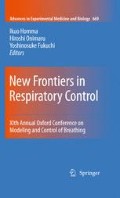Abstract
Dyspnoea, usually defined as an uncomfortable awareness of breathing, is one of the most frequent and distressing symptoms experienced by patients with lung disease. Idiopathic hyperventilation (IHV) has unknown aetiology and little is known about the mechanisms that cause the characteristic sustained hypocapnia and chronic dyspnoea. We have shown in IHV and other chronic respiratory disorders that air hunger is the dominant sensation during exercise, while resting breathlessness is characterised by an affective component. The increased drive to breathe in IHV, and indeed dyspnoea in all chronic respiratory disorders, might be better understood if the central mechanisms of dyspnoea were known. The aim of the present study was to characterise the cortical processing of respiratory-related sensory inputs in patients with IHV. Four patients with IHV were studied with ethical approval. Respiratory stimulation was produced using transient occlusion of inspiration (TIO) during spontaneous breathing (delivered in early inspiration with duration c. 300 ms; this is well tolerated) while BOLD fMRI was performed on a 3 Tesla Siemens Trio. TIO was associated with significant activation in sensorimotor and pre-motor cortical areas and the cerebellum, notably the anterior insula, an area previously associated with breathlessness in healthy volunteers. These preliminary observations on the pattern of brain activity in response to respiratory stimulation support the hypothesis that breathlessness in IHV may reflect inappropriate cortical processing of respiratory-related sensory inputs.
Access this chapter
Tax calculation will be finalised at checkout
Purchases are for personal use only
References
Banzett, R.B., Lansing, R.W., Evans, K.C., and Shea, S.A. (1996) Stimulus – response characteristics of CO2–induced air hunger in normal subjects. Respir Physiol. 103, 19–31.
Banzett, R.B., Mulnier, H.E., Murphy, K., Rosen, S.D., Wise, R.J.S., and Adams, L. (2001) Breathlessness in humans activates the insular cortex. Neuroreport 11, 2117–2120.
Casey, K.L. (1999) Forebrain mechanisms of nociception and pain: Analysis through imaging. PNAS USA. 96, 7668–7674.
Corfield, D.R., Fink, G.R., Ramsay, S.C., Murphy, K., Harty, H.R., Watson, J.D.A., Adams, L., Frackowiak, S.J., and Guz, A. (1995) Evidence of limbic system activation during CO2 – stimulated breathing in man. J. Physiol. 488, 77–84.
Evans, K.C., Banzett, R.B., Adams, L., McKay, L., Frackowiak, R.S.J., and Corfield, D.R. (2001) BOLD fMRI identifies limbic, paralimbic, and cerebellar activation during air hunger. J. Neurophysiol. 88, 1500–1511.
Jack, S., Rossiter, H.B., Pearson, M.G., Ward, S.A., Warburton, C.J., and Whipp, B.J. (2004) Ventilatory responses to inhaled carbon dioxide, hypoxia and exercise in idiopathic hyperventilation. Am J Rev Crit Care Med. 170, 118–125.
Lowe, S., Jack, S., Warburton,C.J., and Calverley, P.M.A. (2001) Does sleep stage affect respiratory pattern in idiopathic hyperventilation? Thorax 56, 45–46.
Manning, H.L., Shea, S.A., Schwartzstein, R.M., Lansing, R.W., Brown, R., and Banzett, R.B. (1992) Reduced tidal volume increases “air hunger” at fixed PCO2 in ventilated quadriplegics. Respir. Physiol. 90, 19–30.
Moosavi, S.H., Golestanian., E., Binks, A.P., Lansing, R.W., Brown, R., and Banzett, R.B. (2003) Hypoxia and hypercapnic drives to breathe generate equivalent levels of air hunger in humans. J. Appl. Physiol. 94, 141–154.
Peiffer, C. (2008) Dyspnea and emotion: What can we learn from functional brain imaging? 177, 937–938.
Peiffer, C., Costes, N., Herve, P., and Garcia–Larrea, L. (2008) Relief of dyspnoea involves characteristic brain activation and a specific quality of sensation. Am. J. Rev. Crit. Care. Med. 177, 440–449.
Price, D.D. (2002) Central neural mechanisms that interrelate sensory and affective dimensions of pain . Mol. Interv. 2, 392–403.
Smith, J.A., Albert, P., Bertella, E., Lester, J., Jack, S., and Calverley, P.M.A. (2009) Qualitative aspects of breathlessness in health and disease. Thorax. Doi 10.1136/thx.2008.104869.
Author information
Authors and Affiliations
Corresponding author
Editor information
Editors and Affiliations
Rights and permissions
Copyright information
© 2010 Springer Science+Business Media, LLC
About this paper
Cite this paper
Jack, S., Kemp, G., Bimson, W., Calverley, P., Corfield, D. (2010). Patterns of Brain Activity in Response to Respiratory Stimulation in Patients with Idiopathic Hyperventilation (IHV).. In: Homma, I., Onimaru, H., Fukuchi, Y. (eds) New Frontiers in Respiratory Control. Advances in Experimental Medicine and Biology, vol 669. Springer, New York, NY. https://doi.org/10.1007/978-1-4419-5692-7_70
Download citation
DOI: https://doi.org/10.1007/978-1-4419-5692-7_70
Published:
Publisher Name: Springer, New York, NY
Print ISBN: 978-1-4419-5691-0
Online ISBN: 978-1-4419-5692-7
eBook Packages: Biomedical and Life SciencesBiomedical and Life Sciences (R0)

